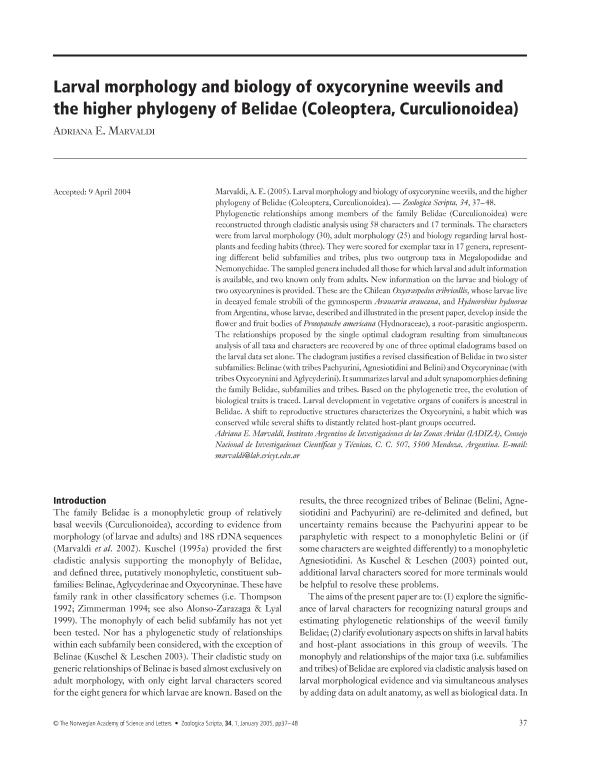Mostrar el registro sencillo del ítem
dc.contributor.author
Marvaldi, Adriana

dc.date.available
2020-06-23T20:32:05Z
dc.date.issued
2005-01
dc.identifier.citation
Marvaldi, Adriana; Larval morphology and biology of oxycorynine weevils and the higher phylogeny of Belidae (Coleoptera, Curculionoidea); Wiley Blackwell Publishing, Inc; Zoologica Scripta; 34; 1; 1-2005; 37-48
dc.identifier.issn
0300-3256
dc.identifier.uri
http://hdl.handle.net/11336/108023
dc.description.abstract
Phylogenetic relationships among members of the family Belidae (Curculionoidea) were reconstructed through cladistic analysis using 58 characters and 17 terminals. The characters were from larval morphology (30), adult morphology (25) and biology regarding larval host‐plants and feeding habits (three). They were scored for exemplar taxa in 17 genera, representing different belid subfamilies and tribes, plus two outgroup taxa in Megalopodidae and Nemonychidae. The sampled genera included all those for which larval and adult information is available, and two known only from adults. New information on the larvae and biology of two oxycorynines is provided. These are the Chilean Oxycraspedus cribricollis , whose larvae live in decayed female strobili of the gymnosperm Araucaria araucana , and Hydnorobius hydnorae from Argentina, whose larvae, described and illustrated in the present paper, develop inside the flower and fruit bodies of Prosopanche americana (Hydnoraceae), a root‐parasitic angiosperm. The relationships proposed by the single optimal cladogram resulting from simultaneous analysis of all taxa and characters are recovered by one of three optimal cladograms based on the larval data set alone. The cladogram justifies a revised classification of Belidae in two sister subfamilies: Belinae (with tribes Pachyurini, Agnesiotidini and Belini) and Oxycoryninae (with tribes Oxycorynini and Aglycyderini). It summarizes larval and adult synapomorphies defining the family Belidae, subfamilies and tribes. Based on the phylogenetic tree, the evolution of biological traits is traced. Larval development in vegetative organs of conifers is ancestral in Belidae. A shift to reproductive structures characterizes the Oxycorynini, a habit which was conserved while several shifts to distantly related host‐plant groups occurred.
dc.format
application/pdf
dc.language.iso
eng
dc.publisher
Wiley Blackwell Publishing, Inc

dc.rights
info:eu-repo/semantics/openAccess
dc.rights.uri
https://creativecommons.org/licenses/by-nc-sa/2.5/ar/
dc.subject.classification
Zoología, Ornitología, Entomología, Etología

dc.subject.classification
Ciencias Biológicas

dc.subject.classification
CIENCIAS NATURALES Y EXACTAS

dc.title
Larval morphology and biology of oxycorynine weevils and the higher phylogeny of Belidae (Coleoptera, Curculionoidea)
dc.type
info:eu-repo/semantics/article
dc.type
info:ar-repo/semantics/artículo
dc.type
info:eu-repo/semantics/publishedVersion
dc.date.updated
2020-03-19T14:37:54Z
dc.journal.volume
34
dc.journal.number
1
dc.journal.pagination
37-48
dc.journal.pais
Reino Unido

dc.journal.ciudad
Londres
dc.description.fil
Fil: Marvaldi, Adriana. Consejo Nacional de Investigaciones Científicas y Técnicas. Centro Científico Tecnológico Conicet - Mendoza. Instituto Argentino de Investigaciones de las Zonas Áridas. Provincia de Mendoza. Instituto Argentino de Investigaciones de las Zonas Áridas. Universidad Nacional de Cuyo. Instituto Argentino de Investigaciones de las Zonas Áridas; Argentina. Universidad Nacional de La Plata. Facultad de Ciencias Naturales y Museo; Argentina
dc.journal.title
Zoologica Scripta

dc.relation.alternativeid
info:eu-repo/semantics/altIdentifier/doi/https://doi.org/10.1111/j.1463-6409.2005.00169.x
dc.relation.alternativeid
info:eu-repo/semantics/altIdentifier/url/https://onlinelibrary.wiley.com/doi/abs/10.1111/j.1463-6409.2005.00169.x
Archivos asociados
